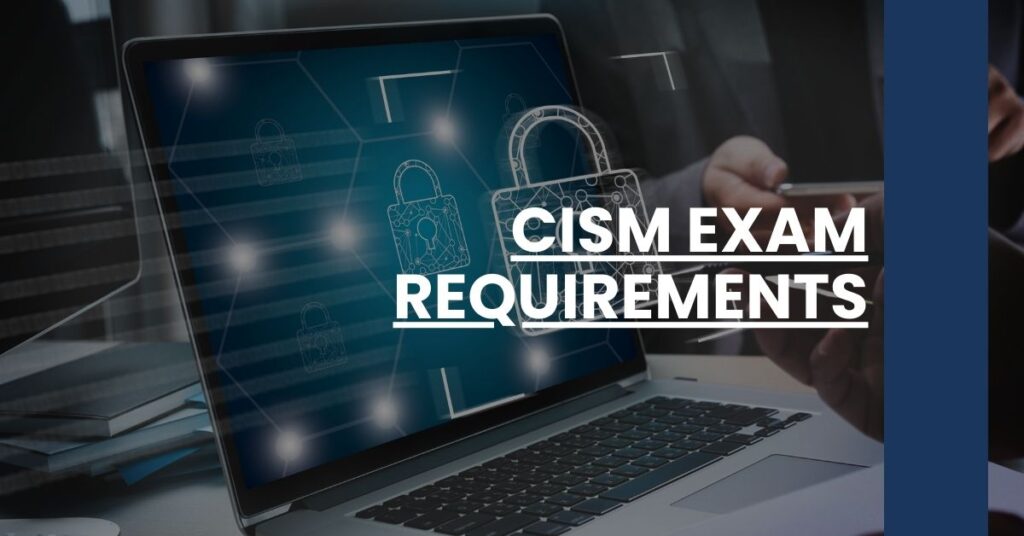Understanding CISM exam requirements is the first step toward a thriving career in information security management.
- Eligibility Criteria: Pinpoint exact criteria for CISM eligibility ensuring you’re on the right path.
- Exam Overview: Get a snapshot of the pertinent details for the CISM examination structure.
- Registration Process: Navigate the specifics of registering with confidence for the CISM test.
Master the intricacies of CISM exam requirements and secure your future.
- Introduction to CISM Certification
- Who Should Consider the CISM Certification?
- CISM Prerequisites and Eligibility
- Overview of the CISM Exam
- Exam Preparation Strategies
- CISM Exam Cost Breakdown
- Requirements After Passing the CISM Exam
- Maintaining Your CISM Certification
- Navigating CISM Recertification
- Alternative Credentials and Further Learning
- Conclusion: Your Path to Becoming a Certified Information Security Manager
Introduction to CISM Certification
The Certified Information Security Manager (CISM) credential is a path that can take your career to new heights. It’s recognized globally as a standard of achievement for those who manage, design, and oversee an enterprise’s information security. When you hold a CISM certification, it sends a clear message that you have a strong understanding of the relationship between an information security program and broader business goals. But before you can add this prestigious title to your resume, you need to understand the CISM exam requirements and how to navigate your way through the process effectively.
Why CISM Matters
In an era where cyber threats loom large, the CISM certification aligns your skill set to industry best practices. It’s not just about having the technical know-how; it’s about being able to manage and adapt to the landscape of cybersecurity risk in way that supports your organization. Here’s how the certification can benefit you:
- Shaping Your Leadership Skills: CISM is designed for management more than those on the frontline, putting you in the driving seat of information security strategies.
- Fostering Recognition: Whether in boardrooms or among peers, the CISM credential helps establish your status as a skilled security professional.
- Increased Earning Potential: Certifications open doors to higher salary brackets and demonstrate your commitment to professional growth.
The Role of a CISM-certified Professional
Imagine you’re at the helm of information security, steering through the intricate waters of protecting and governing data. That is where CISM places you – in pivotal roles that require not just expertise, but foresight and leadership.
Who Should Consider the CISM Certification?
As mentioned, the CISM certification is most beneficial for those already in—or seeking—leadership positions within the information security and IT governance fields. You might be an IT manager, project consultant, or in a supervisory role currently eyeing that next leap.
Ideal CISM Candidates
There’s a variety of roles that could greatly benefit from this certification:
- IT Managers and Directors: Those who manage IT security teams or departments.
- Risk Advisors: Professionals advising on risk management and information security frameworks.
- Security Architects: Those designing security structures in line with business objectives.
- Compliance Officers: Ensuring that companies follow data protection regulations.
CISM Prerequisites and Eligibility
Necessary Experience
To sit for the CISM exam, there are certain prerequisites you must first satisfy. Here’s what you need:
- Work Experience: Five years of professional experience in information security, with at least three years in a managerial role directly related to information security management.
Note: There are some nuances and waivers available for certain educational backgrounds or related certifications.
Meeting the Eligibility Requirements
If you’re thinking of taking the exam, conduct a self-assessment. Align your current experience with the CISM exam requirements and plan how you’ll meet any gaps.
Overview of the CISM Exam
When you understand what awaits you, it makes the seemingly daunting task of taking the CISM exam a lot more manageable.
Exam Format and Content
The CISM exam isn’t just another multiple-choice test. It’s a comprehensive assessment spread across four domains:
- Information Security Governance: Setting and managing strategies aligned with business goals.
- Information Risk Management: Identifying and managing security risks.
- Information Security Program Development and Management: Overseeing and directing security tasks.
- Information Security Incident Management: Handling and responding to incidents.
Number of Questions and Time: You’ll have 4 hours to answer 150 questions that test not just knowledge, but also the application in real-world scenarios.
Exam Preparation Strategies
Preparing for any certification requires strategy, discipline, and the right resources, and the CISM exam is no different. Let’s look at how you can best set yourself up for success.
Create a Study Plan
Time Management: Break down your study schedule to cover all domains, allocating more time to areas where you’re less confident.
Access the Best Study Materials
ISACA Resources: Utilize the official ISACA Study Materials as your core resources. These materials are tailored to the exam content and will provide you with a realistic expectation of what you’ll encounter.
Join a Community
Study Groups and Forums: Discussing tricky topics with peers, and getting fresh perspectives can be invaluable. Engage in forums and study groups for collaborative learning.
Simulate the Exam
Practice Tests: Taking timed practice exams can not just gauge your understanding but also help reduce anxiety by simulating the exam environment.
Ensure you understand the types of questions asked, the reasoning behind answers, and effective time management during the test. Remember, this is about more than passing an exam; it’s about setting a cornerstone for your future career in information security management.
CISM Exam Cost Breakdown
Understanding the financial investment for your CISM certification journey is a crucial piece of the puzzle. The cost can be a determining factor in when and how you’ll take the plunge into this career milestone. Here’s what you need to know about the financial aspect of meeting your CISM exam requirements.
Exam Costs for Members vs. Non-members
The cost of the CISM exam varies, depending on whether you are a member of ISACA or not. Membership does come with a higher upfront fee, but it can save you money in the long run if you plan to pursue multiple certifications or need to retake the exam.
- ISACA Members: $575
- Non-members: $760
Membership entitles you to reduced rates on exam costs, access to a community of experts, and discounts on educational resources.
Retake Fees and Additional Costs
Should you need to take the exam more than once, it’s important to include retake costs in your budget. Additional fees like the $50 application processing fee after passing the exam should also be considered.
Budgeting effectively for your CISM exam is a vital step toward achieving your certification without financial strain.
Requirements After Passing the CISM Exam
Achieving a passing score on your CISM exam propels you towards certification, but it’s not the finish line.
Submitting Evidence of Work Experience
You’ll need to prove that you meet the professional experience requirements. This involves documenting your tenure in related roles, ensuring it aligns with the ISACA work experience requirements. Your hard work in gaining this experience pays off now as it proves your capabilities in the field.
- Experience Verification: Submission of the Verification of Work Experience Form five years of work experience in information security management.
Adherence to the ISACA Code of Professional Ethics
Part of maintaining the integrity of the CISM certification involves committing to ethical practices. ISACA takes this very seriously, and your agreement is a testament to your professionalism.
- Professional Ethics: Upholding the high standards expected of a CISM-affiliated individual is a responsibility that reflects on your professional reputation.
Maintaining Your CISM Certification
Your learning doesn’t end when you receive your certification. The CISM certification requires an ongoing commitment to professional development.
Pursue Continuing Professional Education (CPE)
Remaining certified means meeting ISACA’s CPE policy requirements. This involves engaging in various professional education activities to stay current in the field.
- CPE Credits: Accumulate at least 120 CPE hours over a three-year period to maintain your certification.
Annual Maintenance Fees
There’s an annual fee to keep your certification active. Budget for this ongoing cost as you plan your career development.
- Annual Fees: These fees ensure your certification remains in good standing and supports the services provided by ISACA.
Staying certified showcases your commitment to continuous improvement and adherence to industry standards.
Navigating CISM Recertification
As your certification cycle comes to an end, it’s time to consider recertification.
Timelines and Requirements
Be proactive about the recertification process. Knowing the deadlines and requirements in advance ensures a seamless transition into your next cycle of certification.
- Documentation: Keep a record of your CPE hours as they accumulate to prevent any last-minute rush when it’s time to submit your proof of ongoing education.
Steps to Maintain Active Status
Your active status demonstrates to employers and colleagues that your expertise is up-to-date.
- CPE Submission: Report your CPE hours through the ISACA CPE Reporting System to show that you have fulfilled the requirements.
Renewing your certification is an important career task that reflects your dedication to the information security management profession.
Alternative Credentials and Further Learning
In pursuit of excellence, you might find that continually adding to your professional toolbox is not just beneficial but necessary in the dynamic field of information security.
Complementary Certifications
CISM may be one of many certifications you pursue in your career. Certifications like CISSP or CRISC can augment your expertise and open new avenues for career advancement.
Critical thinking and a diverse skill set are your allies in staying relevant in the ever-evolving security landscape.
Ongoing Training Opportunities
Keep an eye on training courses, webinars, and conferences, as they can be valuable resources for learning and networking.
- Professional Development: Courses tailored to emerging trends help you stay ahead in your field. Utilize resources such as ISACA’s Training Week for in-depth learning experiences.
Always be prepared to evolve as new technologies and challenges emerge in the world of information security.
Conclusion: Your Path to Becoming a Certified Information Security Manager
Your journey to achieving and maintaining your CISM certification is unique, enriched by your dedication and continuous pursuit of knowledge. By understanding all the CISM exam requirements, you’re setting yourself up for success not merely on the exam day but for your future career trajectory. So, take these steps as stepping stones towards broader career horizons, knowing that every requirement fulfilled and every hour of preparation propels you toward becoming a leader in information security management.
This certification not only validates your expertise but also equips you with a prestigious credential that is internationally respected. Step confidently into the realm of information security management, knowing that you have acquired the insight, skills, and credentials to make a difference in your organization and the security community at large. With your CISM certification in hand, you’ll be recognized as an informed, highly skilled professional ready to take on the challenges and opportunities that come your way.

